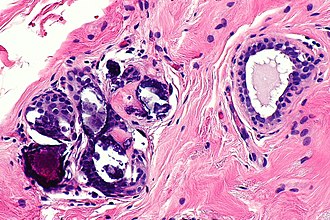Difference between revisions of "Breast calcifications"
Jump to navigation
Jump to search

| Line 1: | Line 1: | ||
[[Image:Calcification in breast benign -- high mag.jpg|thumb|right|Calcification in benign breast tissue. [[H&E stain]]. (WC/Nephron)]] | |||
'''Breast calcifications''' may be found in benign or [[breast cancer|malignant breast]] specimens. | '''Breast calcifications''' may be found in benign or [[breast cancer|malignant breast]] specimens. | ||
| Line 19: | Line 20: | ||
Note: | Note: | ||
*Calcium oxalate - visible with (light) [[polarization]]. | *Calcium oxalate - visible with (light) [[polarization]]. | ||
===Images=== | |||
<gallery> | |||
Image: Calcification in breast benign -- intermed mag.jpg | CBBT - intermed. mag. | |||
Image: Calcification in breast benign -- high mag.jpg | CBBT - high mag. | |||
Image: Calcification in breast benign -- very high mag.jpg | CBBT - very high mag. | |||
</gallery> | |||
==See also== | ==See also== | ||
Revision as of 04:49, 17 June 2016

Calcification in benign breast tissue. H&E stain. (WC/Nephron)
Breast calcifications may be found in benign or malignant breast specimens.
General
- Abnormal breast calcifications are considered a marker of malignancy.
- Radiologists can pick-up calcifications that are approximately 100 micrometers; if "calcs" is on the requisition one needs to find calcs this size.[1]
- The large calcs seen on radiology are approximately 1/5 - 1/6 the size of a HPF, if the field of view (FOV) is ~0.55 mm (as is the case with 22 mm-10x eye pieces and a 40x objective).
Types:
- Calcium phosphate - typically purple.
- Q. How to remember? A. Purple = Phosphate.
- Calcium oxalate - not associated with malignancy.[2]
Microscopic
Features of calcification:
- Purple globs (with concentric rings) on H&E - represent calcium phosphate.
- Often in the lumen of a gland, may be in the stroma.
- Calcific material typically has a well-demarcated border +/- "sharp corners".
Note:
- Calcium oxalate - visible with (light) polarization.


